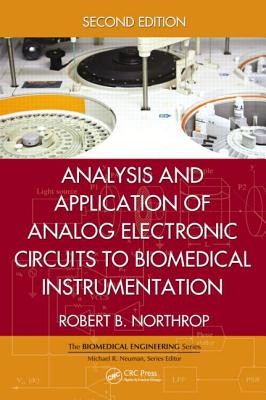
- We will send in 10–14 business days.
- Author: Robert B Northrop
- Publisher: CRC Press
- ISBN-10: 1439866694
- ISBN-13: 9781439866696
- Format: 17.8 x 25.7 x 3.3 cm, hardcover
- Language: English
- SAVE -10% with code: EXTRA
Analysis and Application of Analog Electronic Circuits to Biomedical Instrumentation (e-book) (used book) | bookbook.eu
Reviews
Description
Analysis and Application of Analog Electronic Circuits to Biomedical Instrumentation, Second Edition helps biomedical engineers understand the basic analog electronic circuits used for signal conditioning in biomedical instruments. It explains the function and design of signal conditioning systems using analog ICs--the circuits that enable ECG, EEG, EMG, ERG, tomographic images, biochemical spectrograms, and other crucial medical applications.
This book demonstrates how op amps are the keystone of modern analog signal conditioning system design and illustrates how they can be used to build instrumentation amplifiers, active filters, and many other biomedical instrumentation systems and subsystems. It introduces the mathematical tools used to describe noise and its propagation through linear systems, and it looks at how signal-to-noise ratios can be improved by signal averaging and linear filtering.
Features
- Analyzes the properties of photonic sensors and emitters and the circuits that power them
- Details the design of instrumentation amplifiers and medical isolation amplifiers
- Considers the modulation and demodulation of biomedical signals
- Examines analog power amplifiers, including power op amps and class D (switched) PAs
- Describes wireless patient monitoring, including Wi-Fi and Bluetooth communication protocols
- Explores RFID, GPS, and ultrasonic tags and the design of fractal antennas
- Addresses special analog electronic circuits and systems such as phase-sensitive rectifiers, phase detectors, and IC thermometers
By explaining the building blocks of biomedical systems, the author illustrates the importance of signal conditioning systems in the devices that gather and monitor patients' critical medical information. Fully revised and updated, this second edition includes new chapters, a glossary, and end-of-chapter problems.
What's New in This Edition
- Updated and revised material throughout the book
- A chapter on the applications, circuits, and characteristics of power amplifiers
- A chapter on wireless patient monitoring using UHF telemetry
- A chapter on RFID tags, GPS tags, and ultrasonic tags
- A glossary to help you decode the acronyms and terms used in biomedical electronics, physiology, and biochemistry
- New end-of-chapter problems and examples
EXTRA 10 % discount with code: EXTRA
The promotion ends in 19d.18:08:50
The discount code is valid when purchasing from 10 €. Discounts do not stack.
- Author: Robert B Northrop
- Publisher: CRC Press
- ISBN-10: 1439866694
- ISBN-13: 9781439866696
- Format: 17.8 x 25.7 x 3.3 cm, hardcover
- Language: English English
Analysis and Application of Analog Electronic Circuits to Biomedical Instrumentation, Second Edition helps biomedical engineers understand the basic analog electronic circuits used for signal conditioning in biomedical instruments. It explains the function and design of signal conditioning systems using analog ICs--the circuits that enable ECG, EEG, EMG, ERG, tomographic images, biochemical spectrograms, and other crucial medical applications.
This book demonstrates how op amps are the keystone of modern analog signal conditioning system design and illustrates how they can be used to build instrumentation amplifiers, active filters, and many other biomedical instrumentation systems and subsystems. It introduces the mathematical tools used to describe noise and its propagation through linear systems, and it looks at how signal-to-noise ratios can be improved by signal averaging and linear filtering.
Features
- Analyzes the properties of photonic sensors and emitters and the circuits that power them
- Details the design of instrumentation amplifiers and medical isolation amplifiers
- Considers the modulation and demodulation of biomedical signals
- Examines analog power amplifiers, including power op amps and class D (switched) PAs
- Describes wireless patient monitoring, including Wi-Fi and Bluetooth communication protocols
- Explores RFID, GPS, and ultrasonic tags and the design of fractal antennas
- Addresses special analog electronic circuits and systems such as phase-sensitive rectifiers, phase detectors, and IC thermometers
By explaining the building blocks of biomedical systems, the author illustrates the importance of signal conditioning systems in the devices that gather and monitor patients' critical medical information. Fully revised and updated, this second edition includes new chapters, a glossary, and end-of-chapter problems.
What's New in This Edition
- Updated and revised material throughout the book
- A chapter on the applications, circuits, and characteristics of power amplifiers
- A chapter on wireless patient monitoring using UHF telemetry
- A chapter on RFID tags, GPS tags, and ultrasonic tags
- A glossary to help you decode the acronyms and terms used in biomedical electronics, physiology, and biochemistry
- New end-of-chapter problems and examples


Reviews